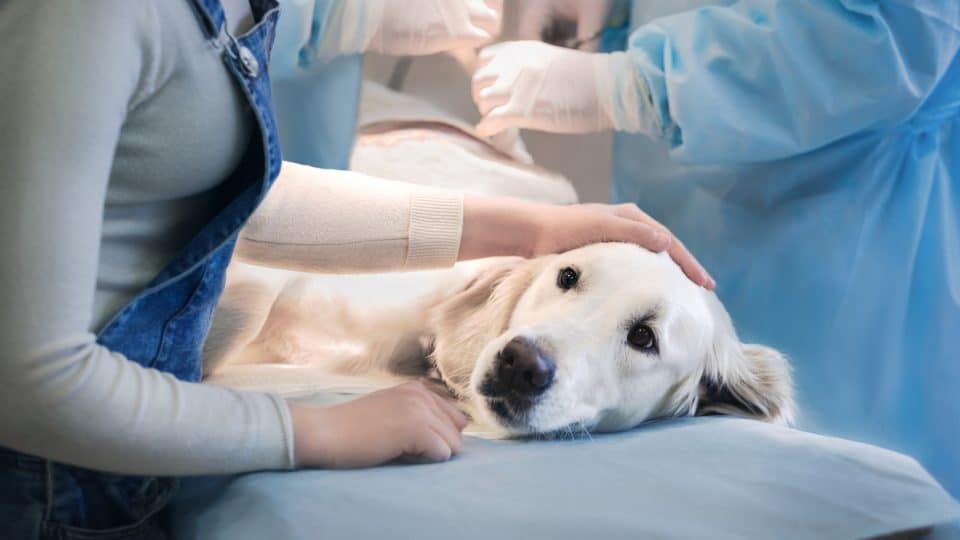- This post contains affiliate links. Read more here.
- Not a substitute for professional veterinary help.
- The insurance advice, products, and links below are intended for and only available in the states where Rover Pet Insurance Services, LLC is licensed as an insurance producer.Full Disclosure
If you’re a pet owner, you know that unexpected health issues can arise at any time. While routine veterinary care is essential, sometimes our pets may require surgery due to accidents, illnesses, or other conditions. In this article, we’ll explore the ins and outs of pet insurance when it comes to surgical procedures.
Does Pet Insurance Cover Surgery?
Does pet insurance cover surgery? The short answer is yes, though there are some exceptions that depend on your provider and your level of coverage.
Understanding Surgery Coverage
Pet insurance coverage for surgeries is typically part of a standard accident and illness plan (though emergency surgeries are often covered under a catastrophic accident-only plan too), so if your pet needs surgery for an accident or a condition that’s not pre-existing, pet insurance will likely provide some coverage for it.
This doesn’t necessarily mean that your bills will be paid, however—pet parents need to take into account the fact that they’ll have deductibles they need to meet first, along with limits to reimbursement rates and coverage maximums laid out in their policies.
Here’s an example of how it could work:
Your dog, Goose, swallows a foreign object while playing at the park. The vet recommends surgery to remove it and estimates the cost to be about $6,000. You’ll have to pay this upfront in full, as most pet insurance policies work on a reimbursement scale.
Your pet insurance policy has a $1,000 deductible, a 90% reimbursement rate, and a $10,000 annual limit.
It’s a new policy year and you haven’t yet needed any treatments for Goose that have applied to the deductible, so you have to meet that first. After you kick in the $1,000 to meet your deductible, your insurance provider will cover 90% of the remaining $5,000 of the procedure.
This comes out to $4,500 that your insurance provider will reimburse you for, making your total financial responsibility $1,500 for the surgery ($1,000 deductible + $500 left to pay after insurance kicks in).
How does the claims process work for surgery coverage?
When your pet requires surgery, you’ll follow a process like you would with any other eligible pet insurance claims.
- Visit your vet: Take your pet to the vet for an exam. After the evaluation, your vet will decide if surgery is necessary.
- Pay upfront: Unless you work with an insurance provider with direct vet pay, you’ll pay for the surgery upfront at your vet’s office.
- Submit your claim: To receive reimbursement from your pet insurance provider for an eligible procedure, you’ll submit a claim with a paid invoice to your insurance provider, along with any necessary medical records. Keep in mind that you’ll need to meet your deductible before you’ll be reimbursed for any treatments.
- Receive your reimbursement: Claims are typically processed anywhere from a few days to a month, with reimbursement following shortly after. Pet parents can typically choose whether to be reimbursed via direct deposit or check in the mail.
What surgeries are typically covered?
Pet insurance policies generally provide coverage for procedures that are used to treat an accident or illness. While exact coverage depends on your policy and provider, that may include:
- Foreign object removal
- Emergency surgeries for accidents, such as broken bones
- Cancer treatments
- Dental surgeries caused by an illness or accident
Some pet parents may opt for catastrophic, accident-only coverage instead of a standard accident and illness plan. Those policies typically only offer surgery coverage for emergencies related to accidents.
Which surgeries are excluded?
While many surgeries are covered, there are certain types that are often excluded from standard pet insurance policies:
- Cosmetic surgeries: Procedures such as tail docking or ear cropping, which are considered cosmetic, are usually not covered.
- Breeding-related surgeries: If you plan to breed your pet, any surgeries related to breeding, such as c-sections or spay/neuter may not be covered. An exception to this may be If a pet parent opts for a wellness add-on to their standard plan—these kinds of plans are preventative care packages that supplement coverage offered in a standard plan. Many offer some coverage for spay or neuter procedures.
- Pre-existing conditions: Surgeries related to pre-existing conditions are usually not covered.
Common Pet Procedures and Costs
Understanding the typical costs of common pet surgeries can help you decide whether or not pet insurance is worth it for you and your pet family. Keep in mind that costs can vary based on factors like location, the severity of the condition, and the specific procedure required. Here are some ballpark figures for common pet surgeries:
| Pet procedure | Average cost |
| Tooth extractions | $500-$2,500 |
| Tumor removal, such as lipoma | $200-$600 |
| Hip replacement | $3,500-$7,000 per hip |
| Orthopedic surgery, such as torn ACL | $2,000-$4,000 |
| Intestinal blockage | $800-$7,000 |
Want to learn more about pet insurance providers and the types of coverage they bring to the table? Read our Best Pet Insurance Guide here.
Further Reading
- Is Pet Insurance Worth It? How To Know If It’s a Good Deal for Your Pet
- What Does Pet Insurance Cover, and How Does It Work? A Beginner’s Guide
- How Does a Pre-Existing Condition Affect Pet Insurance Coverage?
- The Best Pet Insurance Wellness Plans: How Preventive Care Add-Ons Work
- How To Choose the Right Insurance for Your Pet
- How Much Does Pet Insurance Cost?
- What To Know About Waiting Periods and Pet Insurance
- What Are Pet Insurance Deductibles, and How Do You Pick One?
- When Should You Get Pet Insurance?
- Savings Account Versus Pet Insurance: Which Is Better?




